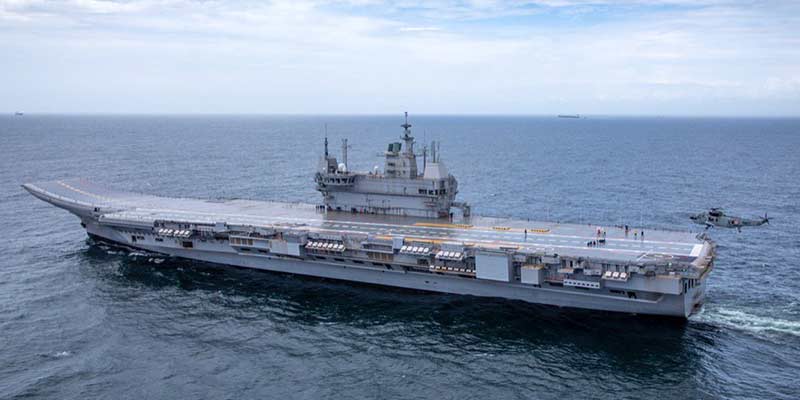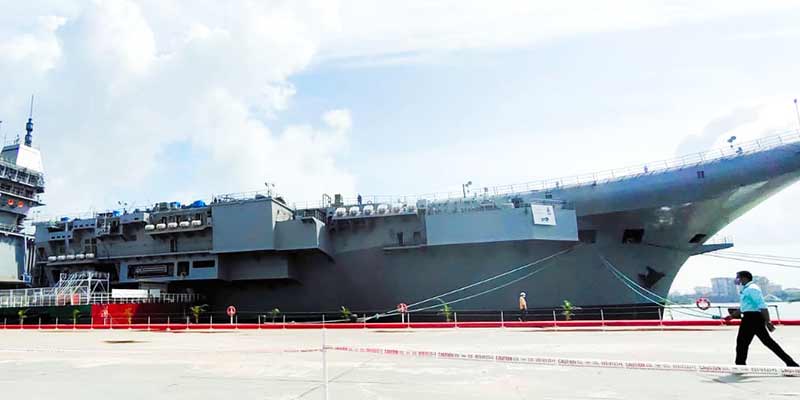- India
- Aug 05
India’s first indigenous aircraft carrier begins sea trials
• India’s first indigenous aircraft carrier (IAC) Vikrant, the largest and most complex warship to be built in the country, began its sea trials.
• The aircraft carrier, with more than 76 per cent indigenous components, is expected to be commissioned into the Indian Navy by August next year after it completes the aviation trials.
• The aircraft carrier set off on its maiden sea trials, 50 years after its namesake played a major role in the 1971 war.
Aircraft carriers in India
• An aircraft carrier is a warship designed to support and operate aircraft, engaged in attacks on targets afloat or ashore and to undertake sustained operations in support of other forces.
• An aircraft carrier is central to the operational requirements and fleet doctrine of the Indian Navy and is the only means of ensuring air defence of sea.
• INS Vikrant, India’s first aircraft carrier was acquired from Great Britain and commissioned on March 4, 1961. INS Vikrant was a Majestic class CATOBAR (Catapult Assisted Take Off but Arrested Recovery) carrier and operated Sea Hawk fighters, Alize (Anti-Submarine Warfare) aircraft and Seaking helicopters.
• India next acquired HMS Hermes, a Centaur class STOVL (Short Take-off and Vertical Landing) carrier and a veteran of the Falkland War. INS Viraat was commissioned on May 12, 1987 as India’s second aircraft carrier and India’s first STOVL carrier operating the Sea Harrier aircraft.
• Soon after the acquisition of INS Viraat, INS Vikrant was also converted from a CATOBAR carrier to a STOVL carrier.
• INS Vikramaditya was commissioned on November 16, 2013. INS Vikramaditya is a Kiev class aircraft carrier which was commissioned by Russian Navy in 1987 under the name Baku. It was later renamed as Admiral Gorshkov and last sailed in 1995 in Russia, before being offered to India. The 44,500 tonne warship has a length of 284 metres.
• INS Vikrant was decommissioned in January 1997.
• INS Viraat was decommissioned in 2017.
• At present, India has only one aircraft carrier — INS Vikramaditya.
Highlights of Vikrant:
• Vikrant, designed by Indian Navy's Directorate of Naval Design (DND), is being built at Cochin Shipyard Limited (CSL). This is the maiden attempt of the Indian Navy and Cochin Shipyard to indigenously design and build an aircraft carrier.
• The ship has been designed with a very high degree of automation for machinery operation, ship navigation and survivability.
• The 40,000-tonne warship, built at a cost of around Rs 23,000 crore, propels India into a select group of countries having capabilities to build state-of-the-art aircraft carriers.
• The warship, which will operate MiG-29K fighter jets, Kamov-31 helicopters, MH-60R multi-role helicopters, has over 2,300 compartments, designed for a crew of around 1,700 people, including specialised cabins to accommodate women officers.
• It would offer an incomparable military instrument with its ability to project Air Power over long distances, including Air Interdiction, Anti-Surface Warfare, offensive and defensive Counter-Air, Airborne Anti-Submarine Warfare and Airborne Early Warning.
• Vikrant has a top speed of around 28 knots and cruising speed of 18 knots with an endurance of about 7,500 nautical miles.
• The ship can accommodate an assortment of fixed-wing and rotary aircraft.
• The IAC is 262 metres long, 62 metres wide and it has a height of 59 metres. Its construction began in 2009.
• Most of the ship construction activities have been completed and the ship has entered the trials phase. Readiness of ship's propulsion and power generation equipment/systems was tested in harbour as part of basin trials.
• Around 550 Indian firms including about 100 MSMEs are registered with the Cochin Shipyard Limited (CSL) and they provided various services for the construction of the IAC.
Manorama Yearbook app is now available on Google Play Store and iOS App Store


